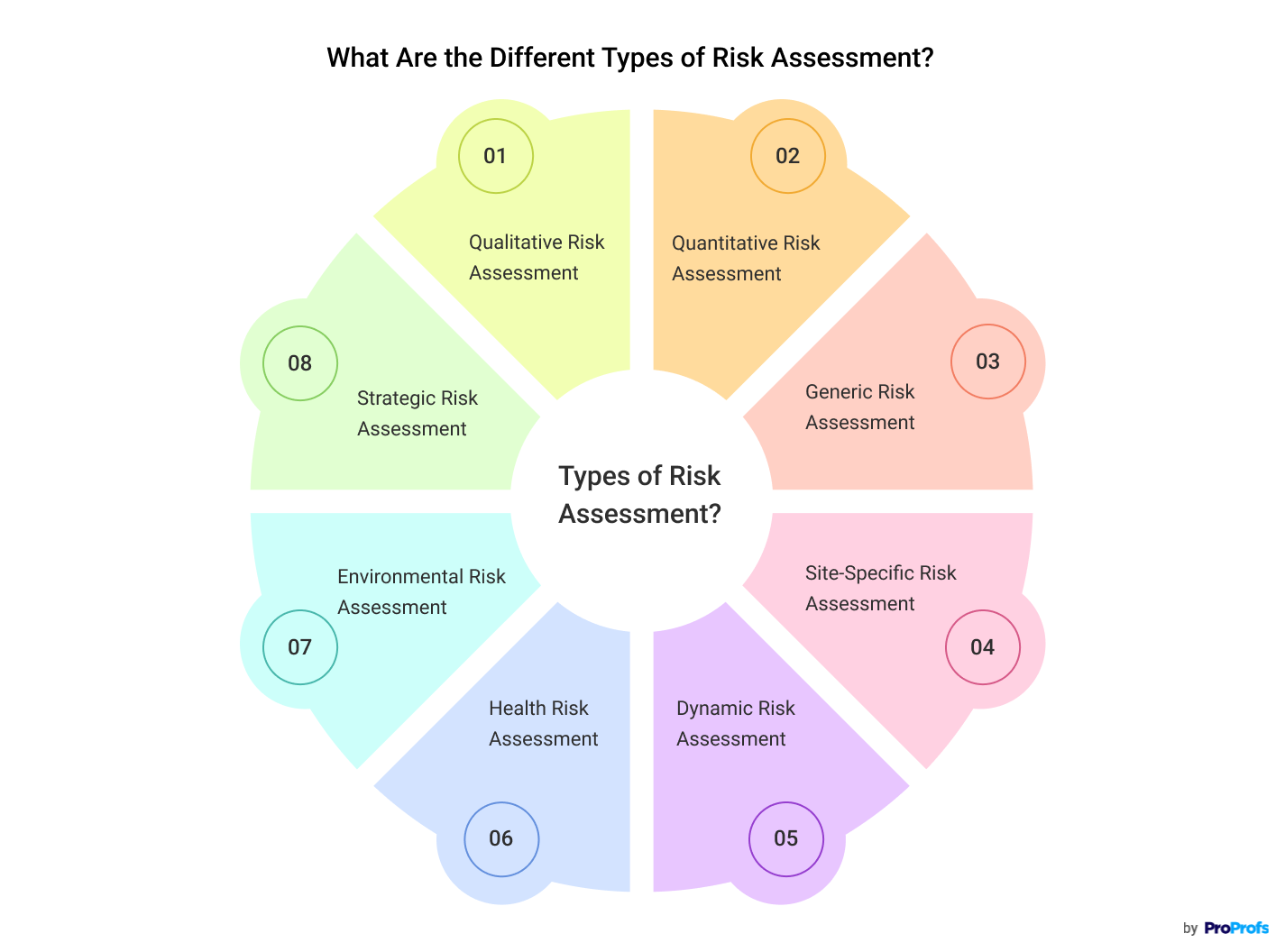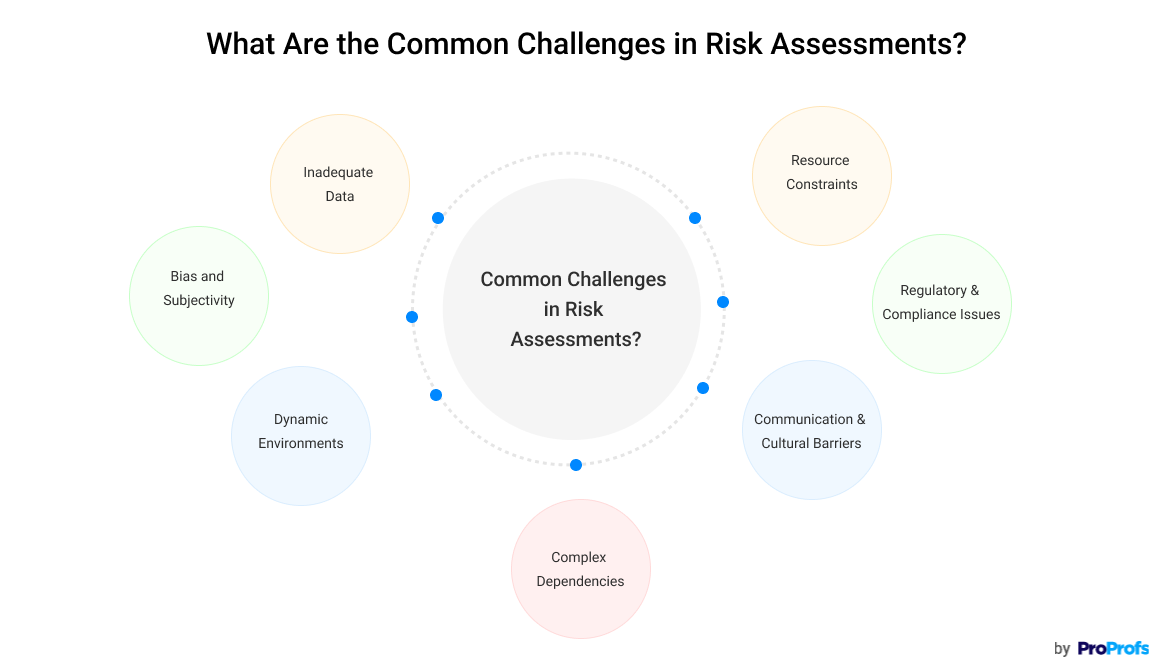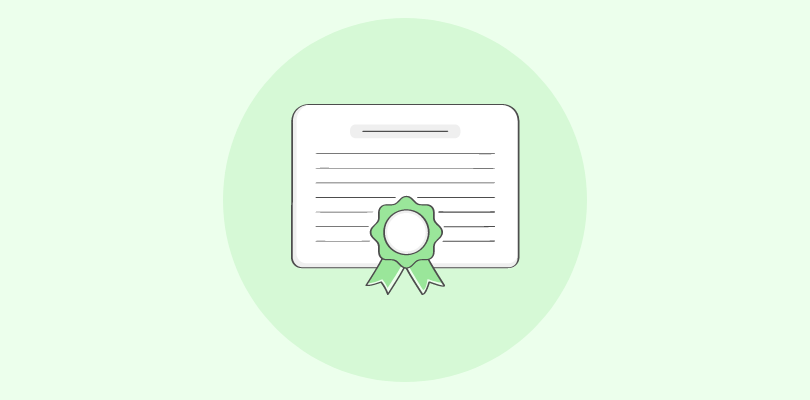Let’s face it: running a business is thrilling. But with all that excitement comes a not-so-secret ingredient – risk. From economic downturns to tech glitches, unexpected events can threaten your progress.
That’s where risk assessments come in – a powerful tool I’ve relied on for years to navigate the ever-changing business landscape.
Let me share with you my experiences in this comprehensive guide, which will be your one-stop shop for mastering risk assessments.
We’ll break down the process step-by-step, identify the different types of risks, and also check the mitigation strategies with online assessment tools, which will not only avert the risks but also turn them into exciting learning opportunities. Here’s a quick video to help you create online assessments using an assessment tool:
What Is a Risk Assessment?
Risk assessment is the process of identifying, evaluating, and prioritizing risks associated with various activities or decisions. This evaluation is crucial for implementing effective risk management strategies, aiming to minimize, monitor, and control the probability or impact of unfortunate events. It is widely used across industries like finance, healthcare, engineering, and information technology. A risk analyst plays a crucial role in this process, identifying potential threats, analyzing their impact, and recommending strategies to mitigate them. For those interested in learning more about this role, resources like Adzuna offer valuable insights and opportunities.
Let’s understand this with risk assessment examples.
For instance, in healthcare, risk assessment might predict potential adverse effects of a new medication, affecting clinical decisions. Financial firms use risk assessments to understand potential investment losses or credit decisions.
A study from cybersecurity shows that about 43% of cyber attacks target small businesses, highlighting the importance of risk assessments in formulating protection strategies.
(Image Source: Small Business Trends)
So, risk assessments help organizations make informed decisions, allocate resources effectively, and enhance safety by foreseeing and mitigating potential threats.
Read: How to Create an Online Assessment for Business or Education
Why Are Risk Assessments Important?
Risk assessments are crucial for several reasons, whether in business, public safety, or everyday life:
- Preventing Harm: By identifying potential risks, organizations can implement measures to prevent injuries, fatalities, and adverse health effects. This is particularly vital in high-risk industries like construction, manufacturing, and healthcare.
- Cost Efficiency: Addressing risks before they manifest as actual problems can save substantial costs related to damages, legal fees, and compensations. It’s generally more cost-effective to prevent issues than to deal with their aftermath.
- Compliance with Legal Requirements: Many jurisdictions require risk assessments as part of regulatory compliance. Failing to conduct risk assessments can lead to fines, penalties, and restrictions.
- Enhancing Decision-Making: Risk assessment provides crucial information that helps leaders make informed decisions. This process can guide the strategic planning, resource allocation, and prioritization of safety measures.
- Maintaining Reputation: Effective risk management can protect an organization’s reputation. Incidents and accidents can lead to negative publicity, which a proactive risk assessment strategy can mitigate.
- Business Continuity: Identifying and managing risks is key to ensuring that business operations can continue smoothly without unexpected disruptions. It helps in planning for contingencies and resilience in the face of crises.
Overall, risk assessment is a fundamental aspect of proactive management, ensuring safety, sustainability, and success in various tasks.
Read More: Benefits of Online Assessments for Learning & Hiring: Going Beyond Traditional Evaluation Methods
What Are the Different Types of Risk Assessment?

Risk assessments are a critical part of managing safety and security in various environments, from workplaces to public spaces. Here are some of the different types of risk assessments:
- Qualitative Risk Assessment
This type uses descriptions rather than numerical values to evaluate the severity and likelihood of risks. It often involves categorizing risks into levels such as low, medium, or high based on expert judgment and experience.
Common Uses: They are used in settings where precise measurements are difficult or unnecessary, such as initial hazard assessments or when detailed data is lacking.
- Quantitative Risk Assessment
This approach uses numerical values to measure risk, typically more precisely calculating the probability and impact. It can involve complex statistical methods and modeling.
Common Uses: These are common in the finance, engineering, and health sectors, where specific risk quantification is crucial for decision-making.
- Generic Risk Assessment
These assessments are used for activities or situations that are common across various locations or organizations. They provide a broad approach and are customized as needed for specific circumstances.
Common Uses: These are useful in standard operating procedures across different sites of the same company or in common industry practices.
- Site-Specific Risk Assessment
This detailed assessment is tailored to the specific characteristics and unique risks of a particular location or situation. It takes into account local factors such as geography, population, or specific operational conditions.
Common Uses: It is essential for construction sites, manufacturing plants, or any setting where the environment significantly influences risk.
- Dynamic Risk Assessment
A real-time, ongoing risk identification and management process is often used in environments where risks can change rapidly, such as emergency services or military operations.
Common Uses: It is useful for first responders, military operations, or any situation requiring immediate decision-making under changing conditions.
- Health Risk Assessment
Focuses specifically on risks that affect individual or public health, evaluating potential exposure to hazardous substances and their possible effects.
Common Uses: Widely used in public health, environmental protection, and workplace safety to manage health hazards.
- Environmental Risk Assessment
Evaluates the potential impacts of actions or projects on the environment, including effects on water, air, soil, and biodiversity.
Common Uses: Essential for construction projects, industrial operations, and any activity requiring environmental permits or compliance with regulations.
- Strategic Risk Assessment
It focuses on long-term risks to the strategic goals of an organization, considering factors that might affect its ability to achieve its objectives.
Common Uses: Businesses and governments use it to plan and execute strategies that anticipate and mitigate potential setbacks.
These types of risk assessments help organizations and individuals make informed decisions, manage potential hazards, and maintain compliance with regulatory requirements.
Each type has its own tools, methodologies, and applications, depending on the specific risks and the context in which they are assessed.
Also Read: 13 Different Types of Assessments You Should Know About
What Are the Steps Followed in a Risk Assessment?
You can avert a lot of potential risks if you follow a systematic risk assessment process, which may contain a few or all of the following steps:
- Identify Hazards: The first step is to pinpoint potential hazards that could cause harm. This could include physical hazards, chemical exposures, ergonomic issues, or any other elements that might pose risks.
- Determine Who May Be Harmed and How: Identify who could be affected by the hazards and understand how they might be harmed. This helps prioritize risk management efforts and tailor preventive measures to protect those at risk.
- Evaluate the Risks: Assess the likelihood and potential severity of harm from each identified hazard. This evaluation helps determine whether existing precautions are adequate or if more should be done to mitigate the risks.
- Implement Controls: Based on the risk evaluation, decide on the appropriate measures to control or eliminate the identified risks. This could involve engineering controls, administrative adjustments, workplace practices, or protective equipment.
- Record the Findings: Document the hazards identified, their associated risks, and the measures put in place to manage them. This documentation is crucial for legal compliance and helps in reviewing the effectiveness of the risk management process.
- Review and Update: Regularly review the risk assessment to ensure it remains up to date with changes in the workplace, technology, and legislation. This step is essential to adapting to new hazards and improving control measures over time.
This systematic approach helps create a safer environment by proactively managing risks, ensuring compliance with regulations, and enhancing overall safety and operational efficiency.
| Take this Health And Safety Risk Assessment Quiz Now |
FREE. All Features. FOREVER!
Try our Forever FREE account with all premium features!
How to Use a Risk Assessment Matrix
What Is a Risk Assessment Matrix?
A risk assessment matrix is a tool for evaluating and prioritizing risks based on their severity of impact and likelihood of occurrence. This matrix helps organizations identify which risks require immediate attention and which can be monitored over time.
It’s commonly used in project management, cybersecurity, and health and safety planning.
How to Use a Risk Assessment Matrix
- Identify Risks: Start by listing all potential risks that could impact your project or operation. These could be financial, legal, operational, or environmental risks, among others.
- Determine the Likelihood: For each risk, assess how likely it is to occur. This is usually rated on a scale (e.g., from “Very Unlikely” to “Very Likely”).
- Assess the Impact: Evaluate what the impact would be if the risk were to materialize. Impact is also rated on a scale (e.g., from “Minor” to “Catastrophic”).
- Plot on the Matrix: Place each risk on the matrix according to its likelihood and impact. This visual representation helps in understanding the risk exposure.
- Prioritize Risks: Analyze the matrix to determine which risks need immediate action (high likelihood and high impact), which should be managed proactively, and which might be acceptable with minimal monitoring.
- Develop Mitigation Strategies: For high-priority risks, develop strategies to mitigate them. This could involve altering processes, increasing security measures, purchasing insurance, or implementing safety protocols.
- Monitor and Review: Regularly review the matrix and update it with new risks or changes in the likelihood and impact of existing risks. This helps maintain an up-to-date view of the organization’s risk landscape.
Using a risk assessment matrix effectively allows organizations to focus resources where they are most needed and to prepare more effectively for potential challenges.
Read More:How to Conduct an Employee Compliance Assessment
What Are the Common Challenges in Risk Assessments?

Risk assessment is a critical process in many fields and can be complex and challenging.
Here are some common challenges in risk assessment and strategies to mitigate them:
- Inadequate Data
There’s often a lack of reliable and sufficient data to identify and analyze risks accurately.
Solution: Invest in better data collection techniques and technologies such as IoT sensors and big data analytics. Using these tools can enhance the accuracy and breadth of data available for risk analysis.
- Bias and Subjectivity
Risk assessments can be skewed by personal biases or subjective judgments, leading to misestimations.
Solution: Standardize risk assessment processes using objective criteria and structured methods like decision matrices. Training assessors in unbiased decision-making and peer reviews can also help minimize subjectivity.
- Dynamic Environments
Rapid changes in the environment can make previous risk assessments outdated quickly.
Solution: Implement continuous monitoring systems and establish regular review cycles for risk assessments to adapt to new information or changes in the environment.
- Complex Dependencies
It’s difficult to understand and analyze the interdependencies in complex systems, which can lead to an oversight in risk assessment questions.
Solution: Employ advanced analytical methods such as systems thinking and network analysis to map and understand complex interdependencies and their potential impacts.
- Communication and Cultural Barriers
Differences in communication styles and cultural backgrounds can lead to misunderstandings or overlooked risks.
Solution: Foster a culture of open communication and inclusivity. Implement multilingual support and culturally sensitive training to ensure all team members can contribute effectively.
- Regulatory and Compliance Issues
Navigating evolving regulatory landscapes can be challenging, and non-compliance can expose the organization to risks.
Solution: Stay updated with regulatory changes through regular training and legal consultations. Implement compliance management systems to track and ensure adherence to relevant laws and regulations.
- Resource Constraints
Limited resources such as budget, time, or expertise can restrict the scope and depth of risk assessments.
Solution: Prioritize risks to focus resources on the most critical areas. Consider outsourcing to third-party experts or adopting technological solutions that can streamline and automate parts of the risk assessment process.
By addressing each challenge with a tailored mitigation strategy, organizations can strengthen their risk management processes and better prepare to handle potential uncertainties.
Also Read:7 Best AI Quiz Generators in 2025
How An Online Assessment Maker Can Assist in Risk Assessments
An online assessment maker can be a highly effective tool for conducting risk assessments across various domains, such as business operations, cybersecurity, and health and safety. Here’s how these tools can assist in streamlining the risk assessment process:
- Systematic Data Collection
Online assessment makers allow organizations to collect data from various sources systematically. They can be used to design surveys and questionnaires that target specific risk-related aspects, ensuring that all relevant data is gathered efficiently.
Watch: Difference Between Quiz, Survey, Scored Survey and Polls
- Standardization of Assessments
These tools help in standardizing the risk assessment process by providing templates and frameworks that can be used across different departments or projects. This standardization ensures consistency in how risks are assessed, making comparisons and analyses more straightforward.
- Scalability
Online test maker tools can easily scale to accommodate large numbers of respondents or complex arrays of risk factors. They can handle vast amounts of data inputs without the need for manual intervention, which is crucial for large organizations or when conducting widespread risk assessments.
- Real-Time Analysis
With built-in analytics capabilities, online assessment makers can provide real-time insights into the data collected. This immediacy allows organizations to quickly identify potential risks and take proactive measures to mitigate them before they escalate.
- Accessibility and Collaboration
These tools are accessible from anywhere with an internet connection, which facilitates collaboration among teams. Different stakeholders can input their data, view reports, and share findings seamlessly, which enhances the decision-making process.
- Cost-Effectiveness
By automating parts of the risk assessment process, such as grading and scoring, online tools can reduce the need for extensive manual labor and the associated costs. They also minimize errors that can occur with manual data handling, potentially saving costs related to error corrections and misjudged risk assessments.
- Compliance and Record-Keeping
Online assessment makers help ensure compliance with industry regulations and standards by maintaining detailed records of all risk assessments conducted. This documentation is crucial during audits and for legal protection.
By leveraging online assessment tools, organizations can enhance the efficiency, accuracy, and effectiveness of their risk assessment processes. This not only contributes to better risk management but also supports overall organizational resilience and strategic decision-making.
Watch: How to Analyze Quiz Results & Reports
Strengthen Your Business Strategy With Effective Risk Assessments
In the dynamic business landscape, the importance of risk assessment cannot be overstated. It serves as a critical tool that helps organizations identify potential threats and vulnerabilities, allowing for the development of effective strategies to mitigate these risks. Regular risk assessments ensure that a business remains resilient and prepared, even in the face of unexpected challenges. You can use innovative risk assessment tools like ProProfs Quiz Maker that allows you to create comprehensive and customized risk assessments online. It contains a smart AI quiz generator, 200+ skill and psychometric assessment templates, and over a million readymade quiz questions to help you create assessments quickly. It ensures that your organization always stays one step ahead in managing and mitigating risks effectively.

 We'd love your feedback!
We'd love your feedback! Thanks for your feedback!
Thanks for your feedback!







